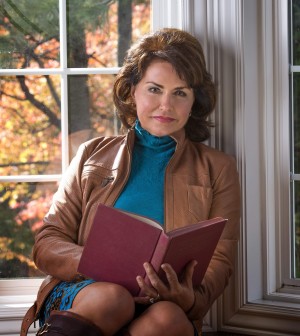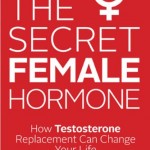- Finding Unshakable Power in a World That Wants to Pull Us ApartPosted 3 months ago
- What could a Donald Trump presidency mean for abortion rights?Posted 3 months ago
- Financial Empowerment: The Game-Changer for Women in Relationships and BeyondPosted 4 months ago
- Mental Health and Wellbeing Tips During and After PregnancyPosted 4 months ago
- Fall Renewal: Step outside your Comfort Zone & Experience Vibrant ChangePosted 5 months ago
- Women Entrepreneurs Need Support SystemsPosted 5 months ago
The Secret Hormone That Saved My Life

by Kathy C.Maupin, M.D.
My trip through hormonal hell began when I was in my early 40s. Long before menopause, I began a free fall into a state of debilitation. I was busy taking care of a husband, a daughter, and a medical practice, and I was involved in many charities, organizations, and political groups. With so much to do, I hardly had time to notice the difference in my mind, body, and soul. I suffered overwhelming fatigue, insomnia, and mood changes. I gained weight, lost interest in sex, and experienced severe PMS (premenstrual syndrome) and migraines, and my personality became flat. Along the way, I lost sight of my own well-being. I did what many do under such stress: I limited my activities to home and office, and cut everything else out of my life.
Before these symptoms began to affect me, I was considered the go-to hormone expert in St. Louis. Some even referred to me as the “hormone queen”! I was already a fan of bio-identical hormones, which are natural because they are made from plants and identical to human hormones, so I treated myself with pure progesterone. Voilà! For a brief time I was back to my normal self!
Unfortunately, though, it didn’t last; I found myself severely limited again. I tried everything I knew, including replacing bio-identical sublingual tablets, vaginal suppositories, and patches and creams with estradiol and progesterone. Nothing worked. I was completely exhausted, unable to sleep, and waking up in the middle of the night with racing thoughts. I gained 20 pounds and was continually depressed. I was too tired to work out, which I had routinely done since college, too swollen to put my wedding ring on, and couldn’t sleep at all. The insomnia was the worst of it because it led to fatigue, crankiness, craving carbs, and other unhealthy habits.
After I completely lost my sex drive, I viewed myself in an asexual way . . . a very subtle change that only my husband noticed. I looked and felt old.
Progesterone obviously was not the answer—something else was missing. I tried conventional hormone treatment and every bio-identical hormone replacement available, yet nothing in my hormone queen’s little black bag could help me! It’s hard to believe now, but at just 43 years old, I hoped I could still be productive. Desperate for help, I sought evaluation by several internists. They all said I was healthy, just “getting old” or “being lazy.” Some even suggested I was crazy and referred me to psychiatrists, all of whom deemed me sane. Most of these physicians talked to me in the exact same way, as if this were all in my head.
Unwilling to accept the doctors’ diagnosis—or lack of one—I researched the problem as best I could for myself. I began to suspect that it was not a group of unrelated symptoms secondary to aging, but some sort of “condition” or “syndrome” related to hormone deprivation. Unfortunately I found very few articles in the OB/GYN literature to help me. I then went back to basic medicine and reviewed the physiology of hormonal balance, but because I did not look for articles specifically about testosterone, and did not look in medical literature outside of the specialties of obstetrics and gynecology, I continued to flounder.
I ultimately concluded that conventional medicine had failed to comprehensively tackle this issue that is so crucial to a majority of women. I also knew I was not alone; I had tried many replacements with conventional and bio-identical hormones of the transdermal, sublingual, and cream types with other patients, who like me felt only slightly better in the end.
Throughout my research, I continued to feel progressively worse in every area. Like many people, I also had other issues: in my case, progressively worsening endometriosis that was going to require a hysterectomy and removal of my ovaries. And, as many other female doctors do, I waited until the pain was so bad that I could not walk. I eventually was forced to face the devastating possibility that I would have to reduce my commitments or perhaps resign my practice altogether. I finally underwent the surgery, hoping that all my symptoms were the result of chronic pain.
My hysterectomy was not a normal surgery. I was given nine liters of fluid to resuscitate me afterward, which caused me to go into cardiac failure. I was entering ARDS, a severe lung malfunction, and was on a respirator when I woke up long before anticipated. I could tell I was in the ICU because I recognized it; I had done my residency at the same hospital more than 20 years earlier. I was alone, with hands and feet restrained so I could not move. The tube in my throat made me feel like I was choking, and I could not reach the call button to summon a nurse, so I kicked my legs until the cardiac monitor went off and two nurses came in.
I struggled to communicate, but it was as if I wasn’t even there. The nurses didn’t acknowledge me, never looked me in the eye, instead talking quietly to one another.
That was when I hit bottom: the worst hour of my life. I prayed to die because I did not want to live as a cardiac cripple.
Then, suddenly, the most amazing thing happened.
The stress of struggling to breathe won out, and I had a near-death experience in the ICU. The serenity and peace I found in the place where I awakened was so wonderful that I wanted to stay there. But I was sent back because, I was told, there was “special work” for me to do.
A dear friend miraculously appeared at my bedside. He unstrapped my hands, removed the tube from my throat, and gave me a pen to write with, which allowed me to communicate and describe what I needed. At that moment everything reversed, and I was home in two days, alive and well.
After months of intense recovery, battling the same problems I described earlier, I was still searching for answers when Gina, a nurse I had known forever, recommended I set up a meeting with her brother, Dr. Gino Tutera. Gino had been replacing hormones with bio-identical subdermal testosterone pellets for more than 20 years, achieving remarkable results. When he treated me, the results were nothing short of miraculous.
Gino taught me about the importance of testosterone in women’s lives. A hormone that we aren’t even aware of could cure all the things that ailed me? It seemed too good to be true. But it wasn’t! Implanting natural bio-identical estradiol and testosterone pellets and replacing Armour Thyroid (natural pig thyroid) brought me back to health and youth! I slept straight through the night the first time I took the pellets, and then every other symptom disappeared! Almost magically, I was my old energetic, healthy, sexual self again.
I have now used bio-identical testosterone pellets for 11 years. I have been free of migraines, and I sleep like a baby. I am down to my pre-disaster weight, and I feel great! All the symptoms that had been haunting me—weight gain, loss of libido, fatigue, and inability to think quickly—have been resolved. I have my life back because of BioBalance pellets. Since my own treatment began, I’ve been trained in administering these same replacement pellets, and I am passionate about spreading the word.
 Featured with permission from the book The Secret Female Hormone: How Testosterone Replacement Can Change Your Life by Kathy C.Maupin, M.D. It is published by Hay House (Available March 2, 2014) and available at all bookstores or online at: www.hayhouse.com.
Featured with permission from the book The Secret Female Hormone: How Testosterone Replacement Can Change Your Life by Kathy C.Maupin, M.D. It is published by Hay House (Available March 2, 2014) and available at all bookstores or online at: www.hayhouse.com.






